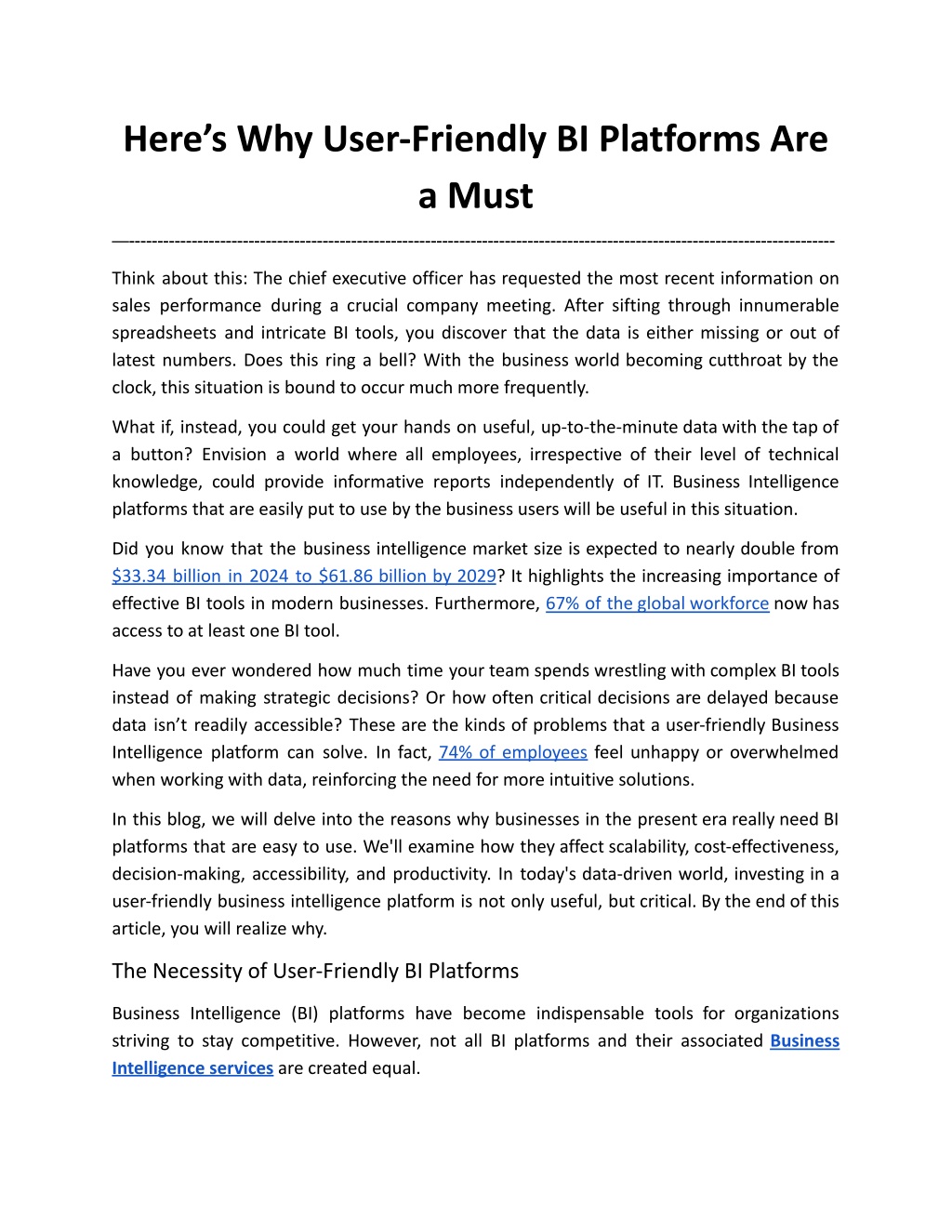
Here’s Why User-Friendly BI Platforms Are a Must
The need for accessible and intuitive Business Intelligence platforms has never been greater. This blog explores the critical reasons why user-friendly BI platforms are essential for modern businesses. We explore how these platforms enable enterprise
Download Presentation

Please find below an Image/Link to download the presentation.
The content on the website is provided AS IS for your information and personal use only. It may not be sold, licensed, or shared on other websites without obtaining consent from the author. Download presentation by click this link. If you encounter any issues during the download, it is possible that the publisher has removed the file from their server.
E N D
Presentation Transcript
Heres Why User-Friendly BI Platforms Are a Must ---------------------------------------------------------------------------------------------------------------------------- Think about this: The chief executive officer has requested the most recent information on sales performance during a crucial company meeting. After sifting through innumerable spreadsheets and intricate BI tools, you discover that the data is either missing or out of latest numbers. Does this ring a bell? With the business world becoming cutthroat by the clock, this situation is bound to occur much more frequently. What if, instead, you could get your hands on useful, up-to-the-minute data with the tap of a button? Envision a world where all employees, irrespective of their level of technical knowledge, could provide informative reports independently of IT. Business Intelligence platforms that are easily put to use by the business users will be useful in this situation. Did you know that the business intelligence market size is expected to nearly double from $33.34 billion in 2024 to $61.86 billion by 2029? It highlights the increasing importance of effective BI tools in modern businesses. Furthermore, 67% of the global workforce now has access to at least one BI tool. Have you ever wondered how much time your team spends wrestling with complex BI tools instead of making strategic decisions? Or how often critical decisions are delayed because data isn t readily accessible? These are the kinds of problems that a user-friendly Business Intelligence platform can solve. In fact, 74% of employees feel unhappy or overwhelmed when working with data, reinforcing the need for more intuitive solutions. In this blog, we will delve into the reasons why businesses in the present era really need BI platforms that are easy to use. We'll examine how they affect scalability, cost-effectiveness, decision-making, accessibility, and productivity. In today's data-driven world, investing in a user-friendly business intelligence platform is not only useful, but critical. By the end of this article, you will realize why. The Necessity of User-Friendly BI Platforms Business Intelligence (BI) platforms have become indispensable tools for organizations striving to stay competitive. However, not all BI platforms and their associated Business Intelligence services are created equal.
Accessibility for All Users The importance of accessibility is clearly visible in the growth of the global web accessibility software market, which is expected to reach $893.7 million by 2031.It states a broader trend towards making technology more accessible and user-friendly, a trend that Business Intelligence platforms must align with to stay relevant and effective. One of the primary reasons user-friendly BI platforms are essential is their accessibility. Traditional BI tools often require a high level of technical expertise, limiting their use to data scientists and IT professionals. This creates a bottleneck where only a few individuals can extract and analyze data, slowing down decision-making processes. User-friendly Business Intelligence platforms break down these barriers by providing intuitive interfaces that even non-technical users can navigate with ease. Features like drag-and-drop functionality and pre-built templates enable employees from various departments to create reports and dashboards without needing specialized training. This democratization of data access ensures that insights can be derived swiftly and efficiently by those who need them most. Enhanced Productivity The impact of user-friendly BI platforms on productivity is significant. When users can easily interact with their BI tools, they spend less time struggling with the software and more time analyzing data and making decisions. For instance, a business analyst using a user-friendly Business Intelligence platform can quickly generate a comprehensive sales report without waiting for the IT department to extract and process the data. Moreover, these platforms often come with self-service analytics capabilities, allowing users to perform complex data queries on their own. This reduces the dependency on IT support, freeing up technical teams to focus on more strategic tasks. The result is a more agile and responsive organization where data-driven decisions can be made promptly. Notably, 70% of employees report that they would be more productive if they were in fewer meetings. By providing easy access to data and enabling self-service analytics, user-friendly Business Intelligence platforms can reduce the need for numerous meetings. Teams can access real-time insights independently, leading to quicker decision-making and enhanced productivity. Improved Decision-Making
User-friendly BI platforms contribute significantly to improved decision-making. When data is easily accessible and understandable, it fosters a culture of data-driven decision-making across the organization. Employees at all levels can leverage insights from the BI platform to inform their strategies and actions. For example, in a retail business, managers can use a Business Intelligence platform to track inventory levels and sales performance in real-time. By identifying trends and anomalies quickly, they can make informed decisions about stock replenishment, promotional activities, and staffing requirements. This level of responsiveness is crucial in maintaining a competitive edge in the market. Cost Efficiency Investing in a user-friendly Business Intelligence platform also translates to cost efficiency. Traditional Business Intelligence services often come with high implementation and training costs due to their complexity. In contrast, user-friendly platforms require minimal training, reducing the overall cost of ownership. Furthermore, because these platforms enable self-service analytics, organizations can save on the costs associated with hiring additional technical staff. The reduced need for external consultants or extensive IT involvement means that businesses can allocate resources more effectively, focusing on growth and innovation rather than troubleshooting and support. Scalability As businesses grow, their data needs evolve. A scalable Business Intelligence platform is crucial to accommodate this growth without requiring significant reconfiguration or additional investment. User-friendly BI platforms are designed to scale seamlessly, ensuring that they can handle increasing data volumes and more complex analytical requirements. For instance, a startup using a user-friendly BI platform can start with basic reporting and gradually expand to more sophisticated analytics as it grows. This flexibility ensures that the BI platform remains a valuable asset throughout the company's lifecycle, providing continuous support for data-driven decision-making. What s The Business Impact of User-Friendly BI Platforms As Business Intelligence platforms have emerged as vital tools for companies seeking to leverage their data effectively, their impact is also measurable. However, the usability of these tools can significantly impact their effectiveness.
Strategic Decision-Making The enhancement of decision-making capabilities to a great extent depends on the availability of easy-to-use Business Intelligence tools. When the usage of data is inclusive in such a manner and the analysis is also seamless, it richochets throughout the organization. This shift is important to make sure that strategic decisions are made based on very current and accurate information. In the process of onboarding new employees to the organization s data strategy, it is important to define what is Business Intelligence and how it can be used to make decisions. This fundamental knowledge makes it easier to assess if all team members are capable of using BI tools in order to support the organization s strategic objectives. For instance, The Younique Foundation s journey with Grow highlights the crucial role of user-friendly Business Intelligence platforms in enhancing decision-making. Before using Grow, the foundation struggled with complex spreadsheets that slowed down their ability to analyze data and respond quickly. Grow s intuitive, customizable dashboards now allow The Younique Foundation to track and analyze essential metrics related to their retreat participants and funding streams effortlessly. This capability enabled them to revamp their online store, aligning products better with their audience, and effectively manage their diverse funding sources to meet federal requirements. Abe Young, Director of Finance and Administration, notes that Grow's real-time metrics have been a standalone in guiding their marketing strategies and ensuring accurate, day-to-day financial tracking, ultimately helping them achieve significant milestones and improve their outreach efforts. Cost Efficiency Saving a ton of money is possible with an easy-to-use Business Intelligence platform. Traditional BI solutions often come with high implementation and training costs due to their complexity. User-friendly platforms, on the other hand, require minimal training, reducing the overall cost of ownership. Furthermore, these platforms enable self-service analytics, which decreases the need for additional technical staff. By empowering employees to generate their own reports and insights, businesses can allocate resources more effectively, focusing on growth and
innovation instead of technical support. This reduction in reliance on external consultants and IT personnel translates into significant cost savings. For example, a financial services firm might use a user-friendly Business Intelligence platform to automate routine reporting tasks, freeing up analysts to focus on more strategic activities. This not only reduces labor costs but also enhances the firm's ability to respond to market changes and client needs more rapidly. Scalability Companies' data requirements get increasingly intricate as they expand. A scalable Business Intelligence platform is essential to accommodate this growth without requiring significant reconfiguration or additional investment. User-friendly BI platforms are designed to scale seamlessly, ensuring they can handle increasing data volumes and more sophisticated analytical requirements. For instance, a startup using a user-friendly BI platform may start with fundamental reporting capabilities and then evolve to sophisticated analytics as the company matures. This scalability makes BI platform relevant for the organization s entire lifecycle and its functionality does not degrade over time in helping the company make intelligent decisions based on data. Suppose, there is an MNC which is planning to compile data from its regional departments and subsidiary companies. The scalable Business Intelligence platform means that different information sources and databases can be integrated into one system and provide information regarding all the aspects of the business. This capability helps in decision-making, control and resource management in the global context. Conclusion Business Intelligence platforms that are easy to use have a way of enriching organizations enabling them with democratized data access, enhanced productivity, and improved decision-making, all while ensuring unimaginable cost savings and scalability. These platforms can easily transform complex data into actionable insights, a factor that makes them essential tools for businesses today. By leveraging a truly powerful and user-centric Business Intelligence platform like Grow, you can flip the script, and narrow down the gap between data and decisions. Some of the features of Grow include an easy to use interface, compatibility with different sources of data and over one hundred data connectors and advanced analytics that is suitable for users
of all expertise. With Grow, you can ensure that everyone in your organization can access the insights they need to drive strategic decisions and operational efficiency. Are you ready to witness the change yourself? Take advantage of Grow s 14-day free demo and explore how a leading user-friendly BI platform like ours can make way for better and streamlined business operations. Visit Capterra Grow.com to read reviews from other users and learn more about how Grow can help you harness the power of your data. Original Source: https://bit.ly/3xDn0yV
















































